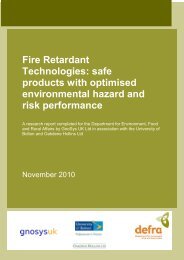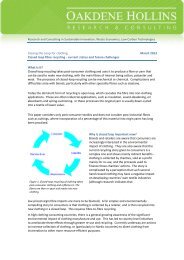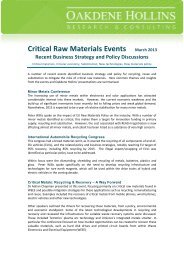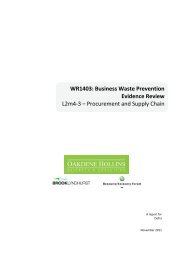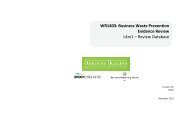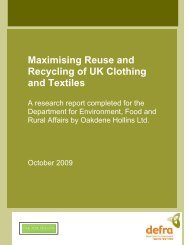Recycling of Low Grade Clothing Waste - Oakdene Hollins
Recycling of Low Grade Clothing Waste - Oakdene Hollins
Recycling of Low Grade Clothing Waste - Oakdene Hollins
Create successful ePaper yourself
Turn your PDF publications into a flip-book with our unique Google optimized e-Paper software.
© <strong>Oakdene</strong> <strong>Hollins</strong> Ltd, Salvation Army Trading Company Ltd<br />
Nonwovens Innovation & Research Institute Ltd September 2006<br />
directly by applying taxes to the pesticides and water used in production in<br />
the country <strong>of</strong> origin. Since the administration costs <strong>of</strong> collecting an ADF<br />
on every textile transaction is likely to be large, this option is unlikely to be<br />
favoured. In the event that further evidence is provided <strong>of</strong> the<br />
environmental benefits arising from higher levels <strong>of</strong> textile recycling, the<br />
use <strong>of</strong> an ADF could finance an improved collection infrastructure.<br />
<strong>Recycling</strong> Targets & PRN’s<br />
Approximately 75% <strong>of</strong> clothing items are not collected. Unlike packaging<br />
glass and metal cans the heterogeneous composition <strong>of</strong> the waste stream<br />
implies that there is currently little value in the 75% <strong>of</strong> clothing that is not<br />
collected. Setting targets at a higher level will tend to draw in a lower<br />
quality <strong>of</strong> used clothing and other textiles and increase the costs <strong>of</strong><br />
collection and sorting. In the light <strong>of</strong> the evidence <strong>of</strong> carbon savings from<br />
recycling these materials compared to some other packaging materials, it<br />
may be a more efficient use <strong>of</strong> recycling funds to increase the level <strong>of</strong><br />
clothing recycling rather than to achieve even higher levels <strong>of</strong> recycling for<br />
glass, paper or wood.<br />
An innovation with minor impact would be the permitting the issuance <strong>of</strong><br />
paper PRN’s (Packaging Recovery Notes) for the use <strong>of</strong> rags in high quality<br />
paper‐making. This may encourage the support <strong>of</strong> a higher recycling level<br />
whilst achieving higher paper recycling targets at a lower cost.<br />
8.7 Conclusions<br />
• In the context <strong>of</strong> the CO2e impacts <strong>of</strong> waste management choices, the<br />
re‐use <strong>of</strong> clothing shows a large and positive (albeit non‐UK) benefit<br />
over recycling or disposal. <strong>Recycling</strong> shows a significant benefit over<br />
landfill and energy recovery and recycling textiles is second only to<br />
aluminium in terms <strong>of</strong> its CO2e benefits compared to other recyclable<br />
components in the household waste stream.<br />
• Charity shops and the textile recycling industry have a positive<br />
environmental benefit, displacing about 8 million tonnes <strong>of</strong> CO2e per<br />
year, albeit not in the UK.<br />
• Textiles present insignificant environmental pollution potential at end<br />
<strong>of</strong> life: there is therefore not, as yet, an evidence base to support<br />
extended producer responsibility (EPR) measures in this sector.<br />
Where there are significant environmental impacts, such as through the<br />
use <strong>of</strong> pesticides in cotton growing, these are best addressed directly in<br />
the local jurisdiction.<br />
For Defra Page 79



